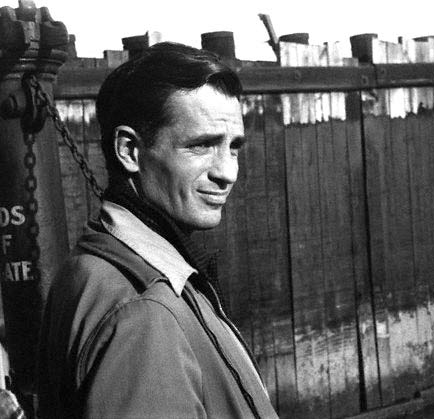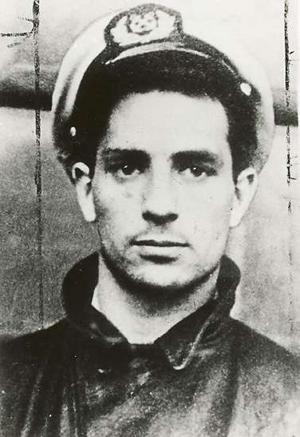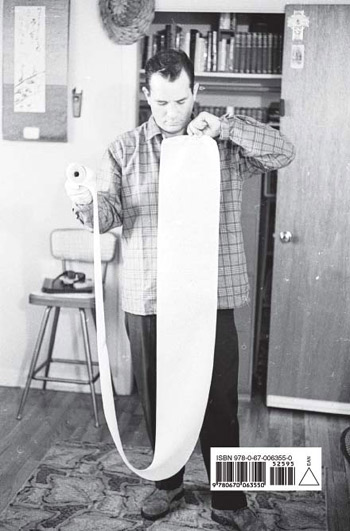Jack Kerouac
From fifties
Contents |
[edit] The Story of Jack Kerouac
The leading members of the Beat movement including: Jack Kerouac, Allen Ginsberg, William S. Burroughs, Neal Cassady, and Gary Snyder’s untraditional viewpoints, that were illustrated in their literature, opened new doors that were not formerly possible in American society, eventually leading to the counter culture movement of the 1960s. These men were the creators of what is now known as the Beat movement and literature. “Yet if anyone was the center f the group, it was Kerouac. He hungered to be a writer, not so much for fame, but for people to listen to him, to take his words and ideas seriously” (Halberstam 299)
[edit] Early Life
Jack Kerouac grew up in a time of fear rightly termed the “Age of Anxiety.” The 1950s where a time of turbulence filled with a tremendous trepidation of war, communism, and nuclear destruction. This panic was driven into the hearts of every American through the media and television. The “New England” small town became an icon in American culture symbolizing wholesomeness and purity. Jack Kerouac grew up in such a town during the depression, attending Catholic schools for much of his childhood; attributing to his conservative, reserved, and somewhat traditional nature, which was uncommon within the Beats (Theado 129). Kerouac grew up in the French quarter of the small town of Lowell Massachusetts. “One of the characters in Jack’s first novel dismisses it as a place with ugly grey houses where no one is interested in truth and beauty” (29). His mother, Gabrielle, and father, Leo, were French Canadian, because of this Jack did not learn to speak English until he was five (Turner 31). Jack and his mother enjoyed an extremely close relationship, he would return to live with her throughout his life. Kerouac grew up in the stifling suburban disillusionment and conformity that is associated with the 1950s, where he was able to truly see the conventionality taking over American society. The heights that this conformity reached are illustrated in James Baldwin’s Another Country, Richard Yates Revolutionary Road, and Grace Metalious’s Peyton Place. His family were Conservative Catholics, attributing to Jacks own political and religious institutions. After completing high school, in Lowell, Jack moved to New York to attend Columbia University on a football scholarship. New York is where he would meet his fellow Beats and become a writer.
[edit] Columbia University
Kerouac and the football coach, Lou, did not get along and after being placed on the bench for much of the season Jack decided that Columbia University was not a match for him and he quickly dropped out in the pursuit of being a writer. “…Go into the American night, the Thomas Wolfe darkness, the hell with these bigshot gangster football coaches, go after being an American writer, tell the truth, don’t be pushed around” (Clark 49). He worked several odd jobs that did not satisfy his inquisitive mind and eventually joined the Navy where he started working on his first novel, The Town and City (51). When he was not at sea Kerouac prowled the streets of New York, usually hanging out with friends his mother did not approve of and listening to jazz in Harlem (Turner 65).
[edit] The Beats
Kerouac developed an intimate relationship with Edie Parker, who would introduce him to Lucian Carr, Allen Ginsberg and William Burroughs. Ginsberg was a young Jewish homosexual that fell in love with Kerouac, they became close friends, but Kerouac was heterosexual for the most part (Clark 61). When Ginsberg and Kerouac met Burroughs they were enamored with him, he was much older and had divorced the traditional society he had grown up in to live the bohemian lifestyle (Turner 69). Kerouac and his friends were attempting to break away from the neatly packaged 1950s when they were dubbed the Beats. Jack Kerouac, Allen Ginsberg, William Burroughs and Lucian Carr would become the center of the Beat movement. However, it was Herbert Huncke, a junky that introduced Burroughs to heroin, which would give Kerouac the term Beat (75). “He came to perceive it as the feeling which characterized all those people he identified with, who had been beaten down and relegated to the margins of society” (76). Kerouac felt that it was only possible to experience the entirety of human experiences by associating with the less conformed lower class, which generally wasn’t besmirched by society (69). This also explains Jack Kerouac’s fascination with African American culture, particularly involving jazz. As a movement the Beats were often misunderstood. "But yet, but yet, woe, woe unto those who think that the Beat Generation means crime, delinquency, immorality, amorality…woe unto those who attack it on the grounds that they simply don’t understand history and the yearnings of human souls…woe unto those who don’t realize America must, will, is changing now, for the better I say. Woe unto those who believe in the atom bomb, who believe in hating mother and fathers, who deny the most important of the ten Commandments, woe unto those (though) who don’t believe in the unbelievable sweetness of sex love, woe onto those who are the standard bearers of death, woe unto those who believe in conflict and horror and violence and fill out books and screens and living rooms with all that crap, woe in fact unto those who make evil movies about the Beat Generation where innocent housewives are rapped by beatniks! Woe unto those who are the real dreary sinners that even God finds room to forgive…woe unto those who spit on the Beat Generation, the wind'll blow it back" (Kerouac 572).
The Beat movement was comprised largely of writers that were challenging the social conformity of the time. Kerouac was intrigued by the bohemian lifestyle and in many ways he tried to model his own life after that. “After twenty-five years in the town (Lowell) and the city (New York), Jack was ready to drink in America, just as Jack London and Thomas Wolfe had done before him” (Turner 85). Jack Kerouac’s new found yearning to see America and live the American Dream was further intensified when he met Neal Cassady. Cassady had had a hard life, his father was an alcoholic vagabond who had brought Neal along with him (Turner 79).Kerouac and Cassady met in the winter of 1946 when Cassady arrived in New York from Denver (Turner 85). They had kindred spirits (86). Their friendship with each other would eventually become one of the most influential in Jacks life, in many ways it prompted him to finally fulfill his desire see America by hitchhiking across it. “I shambled after as I’ve been doing all my life after people who interest me, because the only people for me are the mad ones, the ones who are mad to live, mad to talk, mad to be saved, desirous of everything at the same time, the ones who never yawn or say a commonplace thing, but burn, burn, burn, like fabulous yellow roman candles exploding like spiders across the stars…” (Kerouac) The result was the tremendous book, On the Road, which shaped a movement and propelled it forward.
[edit] On The Road
Although it took about five years to publish On the Road is Jack Kerouac’s most celebrated novel (Halberstam 305). It was published in 1957 and is based on the story of Kerouac’s (Sal Paradise) soul-searching journey across America, accompanied by Cassady (Dean) for much of the journey. It was wildly rejected by publishers as first, but it eventually became one of the most influential novels in the counter culture movement of the 1960s. “It was the celebration of a new lifestyle” (306). Kerouac is quoted as saying, “It was kind of a shock when I found out the On the Road had become a pattern for young people” Theado 137).
[edit] Literature
Beat literature became the testaments of the Beat movement. Jack Kerouac and most of the Beats had a desire to write. Kerouac himself had wanted to write from the time he was a small child. (Clark 32) The literature produced by the Beats was largely influenced by their association with the unconventional in mainstream society (Turner 76). Therefore, Beat literature embodies the essence of the Beat movement. It serves not only as a record of the time period but also as a record of the ideas of the Beats: freedom, adventure, spirituality, and literature. Kerouac and other Beat writers attempted to mimic the inconsistent, sporadic style of jazz in their writing, which Kerouac believed represented the spontaneity and improvisations that the Beats treasured (Beat Culture). Popular books by the Beats include On the Road, Naked Lunch, and Ginsberg’s poem Howl. Kerouac’s books sought to capture what he observed from real life, making his novels raw with honesty. (Tytell 53) Most of Kerouac’s books were searches for spiritual deliverance. “Almost all of his books burn with the age-old question, ‘What must I do to be saved?’ (23)” Beat literature was an active protest against mainstream society.
Jack Kerouac's Book List
The Town and the City 1950, On the Road 1957, The Subterraneans 1958, The Dharma Bums 1958, Doctor Sax 1959, Maggie Cassidy 1959, Mexico City Blues 1959, Book of Dreams 1960, Tristessa 1960, Visions of Cody 1960, The Scripture of the Golden Eternity 1960, Lonesome Traveler 1960, Pull My Daisy 1961, Big Sur 1962, Visions of Gerard 1963, Desolation Angels 1965, Satori in Paris 1966, Vanity of Duluoz 1968, Pic 1971, Scattered Poems 1971, Old Angel Midnight 1973, Trip Trap - Haiku (with Albert Saijo & Lew Welch) 1973, Heaven & Other Poems 1977, San Francisco Blues 1991, Pomes All Sizes 1992, Good Blonde and Others 1993, Book of Blues 1995, Some of the Dharma 1997, Atop an Underwood 1999, Orpheus Emerged 2000 (e-book & audio only), and Book of Dreams 2001.
[edit] Legacy
As the Beat movement transformed from a relatively small, unique group of friends to a large scale, iconic social movement, Jack Kerouac became disenchanted with it. “He claimed to see no connection between his writings and the new generation which revered him as a founding father” (21). The basic idea behind the Beat movement was to be different from everyone else; once it became a trend it lost its true spark for Kerouac (Halberstam 300). He began to disassociate himself from the Beats and his lifelong friends that were connected to it. He wanted his literature to become independent of the Beats and be appreciated by itself as the naked reflection of Kerouac’s own soul. The Beat existence didn’t include national popularity. “…so then what horror I felt in 1957 and later in 1958 naturally to see “Beat” being taken up by everybody” (Kerouac 571)… After his mothers death Kerouac sank further into alcoholism which contributed to his death- just two short years later.
[edit] References
Turner, Steve. Jack Kerouac Angelheaded Hipster. New York, New York. Viking Press. 1996.
Clark, Tom. Jack Kerouac A Biography. New York. Paragon Press. 1990.
Kerouac, Jack. On the Road. New York, New York. Penguin Books. 1976.
Halberstam, David. The Fifties. New York. The Random House Publishing Group. 1993.
Tytell, John. Naked Angels the Classic Account of Three who Changed America’s Literature. New York: Grove Press, 1976.
Theado, Matt. The Dictionary of Literary Biography the Beats a Documentary Series. New York. Gale. 2000.
Kerouac, Jack; Charters, Ann. The Portable Jack Kerouac. New York. Penguin. 1996.
Minnen, Van. Beat Culture: the 1950s and Beyond. New York. Paul and Co Pub Consortium. 1999




